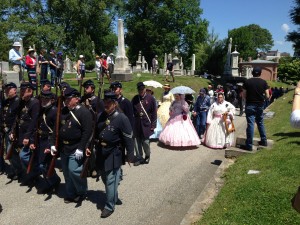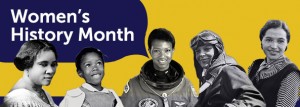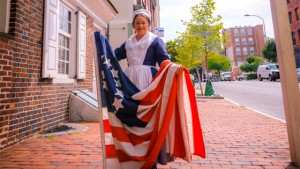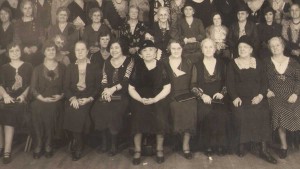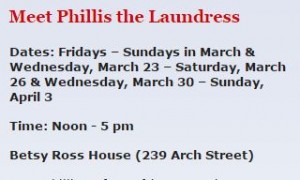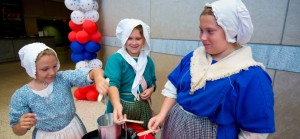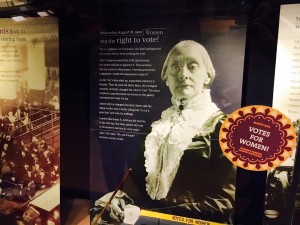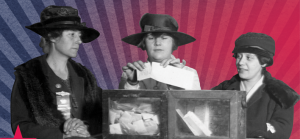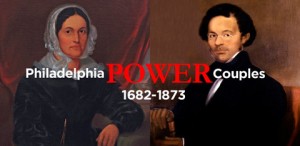 When you think of George Washington, does Martha pop into your mind too? What about Ben and Deborah Franklin? William and Hannah Penn? I attended a very interesting lecture at the Philadelphia History Museum presented by historian Dr. Cynthia Little entitled Philadelphia Power Couples 1682-1873 that examined the dynamics of these and more “Power Couples” and the significant roles that they both played together in defining a nation.
When you think of George Washington, does Martha pop into your mind too? What about Ben and Deborah Franklin? William and Hannah Penn? I attended a very interesting lecture at the Philadelphia History Museum presented by historian Dr. Cynthia Little entitled Philadelphia Power Couples 1682-1873 that examined the dynamics of these and more “Power Couples” and the significant roles that they both played together in defining a nation.
A very broad and complicated topic, my only complaint about this lecture that I enjoyed, was that an hour-long presentation on the subject of the lives of six significant American couples attributed to Philadelphia in some way, could only scratch the surface of the complexity of these figures and their relationships. She did however provide several sources to keep digging to conduct a deeper personal analysis of these individuals, and explain that this topic is a work in progress. Despite this, Dr. Little was able to fit quite a bit of engaging and interesting content on them. Dr. Little presented the argument as supported by other scholars, that powerful men in American history are equal part of the relationship with their female spouses, and in many cases these women offer a more significant contribution to the American story than their husbands. This Women’s History Month event clearly recognized that. We shouldn’t just think about the Founding Fathers, we should include the founding mothers as well, together, the Founding parents? That certainly is a different way to look at our deeply ingrained narrative of American history as one led by men. Clearly, this isn’t exclusively the case.
Dr. Little examined the relationships between William Penn and Hannah Callowhill Penn, George and Martha Washington, Benjamin and Deborah Franklin, John Ross and Betsy Claypoole—better known as Ross, Richard and Sarah Allen, Stephen and Harriet Smith, and James and Lucretia Mott. These women and men lived extraordinary lives and played a tremendous role in shaping our nation. This is a very varied group of individuals, some very wealthy, some middle class, some free Whites, others free Blacks, and former slaves. One important distinction that must be made is that this group was people with some affluence, status and control in society, and able to practice considerable agency. This likely would not have been the case for most early Americans whose roles would be clearly defined and prescribed and would not experience a similar status as a “power couple.” Alexis de Tocqueville said: “American women never manage the outward concerns of the family, or conduct a business or take part in a political life…no families, are so poor as to form an exception to this rule” (DuBois and Dumenil 187-188). DuBois and Dumenil establish that de Tocqueville’s statement in the 1830s was not always true and “contradicted these assertions” (DuBois and Dumenil 188).
I enjoyed Dr. Little’s inclusion of people who as she stated, “Are people who I think really deserve to be more household names because of their importance in Philadelphia” (Little). People who most people don’t know, but should. This holds true with the Smiths, who were born into slavery, bought their freedom, and become incredibly successful businesspeople both in their own right. “They are really if not the, among probably the top five or ten wealthiest Black families in the United States” (Little). They used their money to support the cause of abolition and to assist escaped slaves. While little is known about Harriet Smith, what is known about her business acumen, and her involvement with the Philadelphia Female Anti-Slavery Society and the Women’s Association of Philadelphia, both organizations were immensely active in the cause of abolition (Little).
Another example of the inclusion of a lesser-known couple (at least outside of Philadelphia) is William and Hannah Callowhill Penn. Many tourists visiting Philadelphia to be convinced that it is Ben Franklin, Philadelphia’s most famous citizen—also included in this lecture, who sits atop City Hall, and not its founder William Penn. William Penn’s founding and running of Pennsylvania was not a job that only fell on his responsibility, but Hannah’s as well. Experienced in accounting and financial matters, Hannah, Penn’s second wife proved to be helpful in these areas, as he was not. Hannah managed both of Penn’s estates and organizational issues (Little). Most interesting is what happens in 1712, William Penn in failing health, suffers a stroke and is rendered incapable of managing the operations and affairs of his proprietary colony of Pennsylvania. Hannah Penn, a woman, takes over and then becomes the proprietor of Pennsylvania (Little). “Both of William Penn’s marriages appear to have been deeply affectionate relationships, but his biographers have portrayed the first as a love match, the second as a matter of convenience” (Hirsch 430). Hannah Penn herself interestingly was hesitant to take over management of Pennsylvania after Penn’s death “for fear of mismanagement” and was “but a woman” (Hirsch 433). Nonetheless, she successfully exercised tremendous agency and control in the first quarter of the eighteenth century, overseeing Pennsylvania.
Philadelphia Power Couples presented the interesting perspective of the powerful women behind, or should I say next to some of the most powerful and significant men in Philadelphia history up to the end of the nineteenth century. These women exercised tremendous authority as skilled craftspeople, businesswomen, dignitaries, philanthropists, religious leaders, and agents for social change. Some of them like Martha Washington, Deborah Franklin and Hannah Penn have often ignored by history and overshadowed by their powerful husbands, but still provided much support to their marriages and accomplishments than is traditionally recognized. Others like Betsy Ross, Sarah Allen, and Harriet Smith far outpace their husbands in their accomplishments or equally match them, and served a considerable amount of time in the spotlight dedicated to various causes, though both partners had something to contribute in their powerful marriages as power couples leading center stage in Philadelphia life was the perfect way to celebrate Women’s History Month with acknowledging and celebrating powerful women who played an important role in this time in Philadelphia and the nation.
Bibliography
Little, Cynthia. “Philadelphia Power Couples 1682-1873.” Philadelphia History Museum. Philadelphia. 24 Mar. 2016. Lecture.
Hirsch, Alison Duncan. “A Tale of Two Wives: Mythmaking and the Lives of Gulielma and Hannah Penn. William Penn: To Honor His 350th Anniversary. Spec. issue of Pennsylvania History: A Journal of Mid-Atlantic Studies 61.4 (1994): 429-56. Print.
DuBois, Ellen Carol, and Lynn Dumenil. “Pedestal, Loom, and Auction Block.” Through Women’s Eyes. Boston: Bedford/St. Martin’s, 2012. 186-251. Print.

